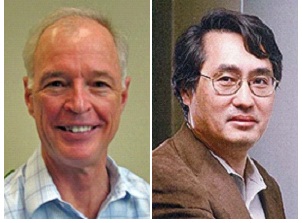Researchers from the cancer nanotechnology and signal transduction and therapeutics programs of UCLA’s Jonsson Comprehensive Cancer Center (JCCC) have developed an innovative technique that can carry chemotherapy safely and release it inside cancer cells when triggered by two-photon laser in the infrared red wave length.
Drs. Jeffrey Zink, professor of chemistry and biochemistry, and Fuyu Tamanoi, professor of microbiology, immunology and molecular genetics, and colleagues published their findings in the journal Small online ahead of print on February 20, 2014.
 Dr. Jeffrey Zink and Dr. Fuyu Tamanoi
Dr. Jeffrey Zink and Dr. Fuyu Tamanoi
A light-activated drug delivery system is particularly promising, because it can accomplish spatial and temporal control of drug release. Finding ways to deliver and release anticancer drugs in a controlled manner that only hits the tumor can greatly reduce the amount of side effects from treatment, and also greatly increase the cancer-killing efficacy of the drugs. The difficulty of treating cancer often derives from the difficulties of getting anticancer chemotherapy drugs to tumor cells without damaging healthy tissue in the process. Many cancer patients experience treatment side effects that are the result of drug exposure to healthy tissues.
A major challenge in the development of light-activated drug delivery is to design a system that can respond to tissue-penetrating light. Drs. Tamanoi and Zink joined their diverse teams and collaborated with Dr. Jean-Olivier Durand at University of Montpellier, France to develop a new type of microscopic particles (nanoparticles) that can absorb energy from tissue-penetrating light that releases drugs in cancer cells.
These new nanoparticles are equipped with specially designed nanovalves that can control release of anticancer drugs from thousands of pores, or tiny tubes, which hold molecules of chemotherapy drugs within them. The ends of the pores are blocked with capping molecules that hold the drug in like a cork in a bottle. The nanovalves contain special molecules that respond to the energy from two-photon light exposure, which opens the pores and releases the anticancer drugs. The operation of the nanoparticles was demonstrated in the laboratory using human breast cancer cells.
Because the effective depth range of the two-photon laser in the infrared red wavelength can reach 4 centimeters from the skin surface, this delivery system is best for tumors that can be reached within that range, which possibly include breast, stomach, colon, and ovarian cancers.
Another feature of the nanoparticles is that they are fluorescent and thus can be tracked in the body with molecular imaging techniques. This allows the researchers to track the progress of the nanoparticle into the cancer cell to insure that it is in its target before light activation. This ability to track a targeted therapy to its target has been given the name “theranostics” (a portmanteau of therapy and diagnostics) in the scientific literature.
“We have a wonderful collaboration,” said Zink, “when the JCCC brings together totally diverse fields, in this case a physical chemist and a cell signaling scientist, we can do things that neither one could do alone.”
“Our collaboration with scientists at Charles Gerhardt Institute was important to the success of this two-photon activated technique,” said Tamanoi, “which provides controls over drug delivery to allow local treatment that dramatically reduces side effects.”
This research was supported by the National Institutes of Health (NIH) and the Partner University Fund (FACE-PUF).
UCLA's Jonsson Comprehensive Cancer Center has more than 240 researchers and clinicians engaged in disease research, prevention, detection, control, treatment and education. One of the nation's largest comprehensive cancer centers, the Jonsson center is dedicated to promoting research and translating basic science into leading-edge clinical studies. In July 2013, the Jonsson Cancer Center was named among the top 12 cancer centers nationwide by U.S. News & World Report, a ranking it has held for 14 consecutive years. For more information on the Jonsson Cancer Center, visit our website at http://www.cancer.ucla.edu.